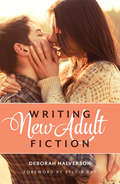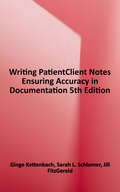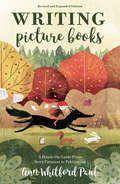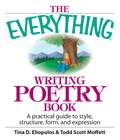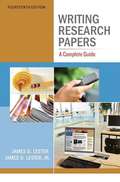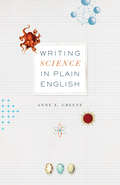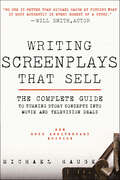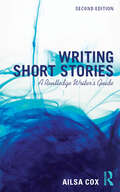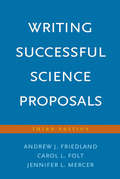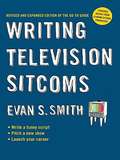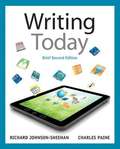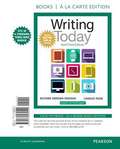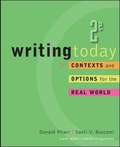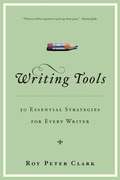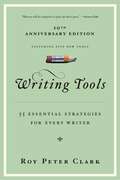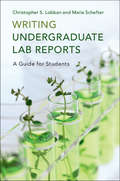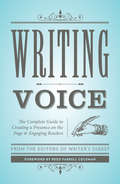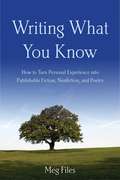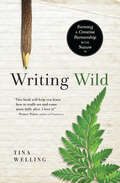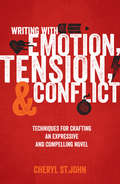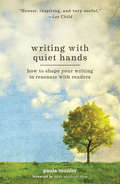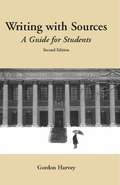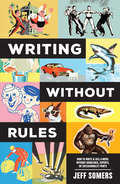- Table View
- List View
Writing New Adult Fiction: How to Write and Sell New-Adult Fiction
by Deborah HalversonJoin the New Adult Fiction revolution! From Sylvia Day's Bared to You to Jamie McGuire's Beautiful Disaster, new adult fiction has arrived--and it's hotter than ever. But there's more to this category than its 18-to-26-year-old characters: The success of your story depends on authentically depicting the transition of your young protagonists from teenhood to adulthood. With Writing New Adult Fiction, you'll learn how to capture the spirit of freedom, self-discovery, and romance that defines the new adult experience. Create memorable characters that act and sound like new adults. Sculpt a distinct personality for your fiction with POV, voice, tone, and word choices. Build a unique, captivating plot that satisfies your audience from beginning to end. Learn tools for revising effectively and efficiently in a speed-driven market. Weigh the options for your path to publication: traditional, indie, and hybrid. The new adult category is filled with opportunities to break in with distinct plots and original characters. Make your mark by writing a novel that's fresh, unique--and wholly new adult!
Writing Patient/Client Notes: Ensuring Accuracy in Documentation
by Ginge Kettenbach Sarah L. Schlomer Jill FitzGeraldMaster the hows and whys of documentation! Develop all of the skills you need to write clear, concise, and defensible patient/client care notes using a variety of tools, including SOAP notes. <p><p>This is the ideal resource for any health care professional needing to learn or improve their skills--with simple, straightforward explanations of the hows and whys of documentation. It also keeps pace with the changes in Physical Therapy practice today, emphasizing the Patient/Client Management and WHO's ICF model.Section by section you'll learn how to document clearly and accurately, while exercise by exercise you'll practice mastering every step.
Writing Picture Books Revised and Expanded Edition: A Hands-On Guide From Story Creation to Publication
by Ann Whitford PaulMaster the Art of Writing Enthralling Tales for the Youngest pre-and emerging readers! Fully updated and thoroughly revised, Writing Picture Books Revised and Expanded Edition is the go-to resource for writers crafting stories for children ages two to eight. You'll learn the unique set of skills it takes to bring your story to life by using tightly focused text and leaving room for the illustrator to be creative. Award-winning author Ann Whitford Paul helps you develop the skills you need by walking you through techniques and exercises specifically for picture book writers. You'll find:Instruction on generating ideas, creating characters, point-of-view, beginnings and endings, plotting, word count, rhyme, and moreUnique methods for using poetic techniques to enrich your writingHands-on revision exercises (get out your scissors, tape, and highlighters) to help identify problems and improve your picture book manuscriptsUpdated tips for researching the changing picture book market, approaching publishers, working with an agent, and developing a platformAll new quizzes and examples from picture books throughoutNew chapters cover issues such as page turns, agents, and self-publishingWhether you're just starting out as a picture book writer or have tried unsuccessfully to get your work published, Writing Picture Books Revised and Expanded Edition is just what you need to craft picture books that will appeal to young children and parents, and agents and editors.
Writing Poetry Book (The Everything )
by Todd Scott Moffett Tina D EliopulosGiving voice to ''what gets lost in translation'' is the challenge every poet faces. With The Everything Writing Poetry Book, that challenge just got easier. Featuring examples from works of celebrated poets and instruction on communicating your ideas, this clear and accessible reference helps you gain confidence as you find your own voice. Written by a team who each hold a master’s degree and teach creative writing and literature, this easy-to-follow guide has all you need to take your work to the next level. - With this handy guide, you will learn to:Create meter and rhyme - Express your innermost thoughts - Use imagery and metaphor - Polish your word play - Find your own rhythm - Work with other writersand more - The Everything Writing Poetry Book helps you make the most of this rewarding craft - whether you’re a fledgling poet or a seasoned wordsmith.
Writing Research Papers: A Complete Guide (Fourteenth Edition)
by James D. LesterThis market-leading text provides readers with step-by-step guidance through the research writing process, from selecting and narrowing a topic to formatting the finished document. Writing Research Papers backs up its instruction with the most complete array of samples of any writing guide of this nature. The text continues its extremely thorough and accurate coverage of citation styles for a wide variety of disciplines. The fourteenth edition maintains Lester's successful approach while bringing new writing and documentation updates to assist the student researcher in keeping pace with electronic sources.
Writing Science in Plain English
by Anne E. GreeneScientific writing is often dry, wordy, and difficult to understand. But, as Anne E. Greene shows in Writing Science in Plain English,writers from all scientific disciplines can learn to produce clear, concise prose by mastering just a few simple principles. This short, focused guide presents a dozen such principles based on what readers need in order to understand complex information, including concrete subjects, strong verbs, consistent terms, and organized paragraphs. The author, a biologist and an experienced teacher of scientific writing, illustrates each principle with real-life examples of both good and bad writing and shows how to revise bad writing to make it clearer and more concise. She ends each chapter with practice exercises so that readers can come away with new writing skills after just one sitting. Writing Science in Plain English can help writers at all levels of their academic and professional careers--undergraduate students working on research reports, established scientists writing articles and grant proposals, or agency employees working to follow the Plain Writing Act. This essential resource is the perfect companion for all who seek to write science effectively.
Writing Science in Plain English, Second Edition (Chicago Guides to Writing, Editing, and Publishing)
by Anne E. GreeneAn updated edition of the essential guide for all scientists—from undergraduates to senior scholars—who want to produce prose that anyone can understand. Scientific writing is often dry, wordy, and difficult to understand. But, as biologist and experienced teacher of scientific writing Anne E. Greene shows in Writing Science in Plain English, writers from all scientific disciplines can learn to produce clear, concise prose by mastering just a few simple principles. This short, focused guide presents roughly a dozen such principles based on what readers need to understand complex information, including concrete subjects, strong verbs, consistent terms, organized paragraphs, and correct sentence structure. Greene illustrates each principle with real-life examples of both good and bad writing and shows how bad writing might be improved. She ends each chapter with revision exercises (and provides suggested answers in a separate key) so that readers can come away with new writing skills after just one sitting. To help readers understand the grammatical terms used in the book, an appendix offers a refresher course on basic grammar. For this second edition, Greene has incorporated the latest research on what makes writing effective and engaging and has revised or replaced exercises and exercise keys where needed. She has also added new features that make it easier to navigate the book. A new resource for instructors who use Writing Science in Plain English in their classes is a free, online teacher’s guide. Drawn from Greene’s long experience teaching students how to write science clearly, the teacher’s guide provides additional lectures, assignments, and activities that will inform and enliven any class.
Writing Screenplays That Sell: The Complete Guide to Turning Story Concepts into Movie and Television Deals
by Michael HaugeFor more than twenty years, Writing Screenplays That Sell has been hailed as the most complete guide available on the art, craft, and business of writing for movies and television. Now fully revised and updated to reflect the latest trends and scripts, Hollywood story expert and script consultant Michael Hauge walks readers through every step of writing and selling successful screenplays. If you read only one book on the screenwriter's craft, this must be the one.
Writing Short Stories: A Routledge Writer's Guide
by Ailsa CoxThis new edition of Writing Short Stories has been updated throughout to include new and revised exercises, up-to-date coverage of emerging technologies and a new glossary of key terms and techniques. Ailsa Cox, a published short-story writer, guides the reader through the key aspects of the craft, provides a variety of case studies and examples of how others have approached the genre and sets a series of engaging exercises to help hone your skills. This inspiring book is the ideal guide for those new to the genre or for anyone wanting to improve their technique.
Writing Successful Science Proposals: Third Edition
by Andrew J. Friedland Carol L Folt Jennifer L. MercerAn authoritative how-to guide that explains every aspect of science proposal writing This fully revised edition of the authoritative guide to science proposal writing is an essential tool for any researcher embarking on a grant or thesis application. In accessible steps, the authors detail every stage of proposal writing, from conceiving and designing a project to analyzing data, synthesizing results, estimating a budget, and addressing reviewer comments and resubmitting. This new edition is updated to address changes and developments over the past decade, including identifying opportunities and navigating the challenging proposal funding environment. The only how-to book of its kind, it includes exercises to help readers stay on track as they develop their grant proposals and is designed for those in the physical, life, environmental, biomedical, and social sciences, as well as engineering.
Writing Television Sitcoms (revised)
by Evan S. SmithNew edition of the popular screenwriting guide! Writing Television Sitcoms is the ultimate all-in-one guide to writing a funny script, pitching a new show, and launching a successful career. AS digital technology reshapes the television industry, this new and expanded edition explains how today's writers can get ahead of the curve. Features include: ? A complete description of premise-driven comedy, a proven method for "writing funny from the ground up" ? Numerous examples from new and classic shows ? Advice from top writer-producers ? A thorough look at how sitcom story models are changing ? Complete script layout guidelines for all three formats ? Tips on how new-media developments can help you break into the business
Writing Today (Brief Edition)
by Richard Johnson-Sheehan Charles PaineWith a clear and easy-to-read presentation, visual instruction and pedagogical support, Writing Today is a practical and useful guide to writing for college and beyond. This text teaches how to transfer their writing skills to careers. By teaching kinds of writing (analyses, reports, proposals, etc. ), strategies for writing (narration, comparison, argumentation, etc. ), and processes for writing (planning, drafting, revising, etc. ), Writing Today provides the writer with tools they can mix and match as needed to respond effectively to many writing situations.
Writing Today (Brief Third Edition)
by Richard Johnson-Sheehan Charles PaineThis version of Writing Today, Brief Edition has been updated to reflect the 8th edition of the MLA Handbook (April 2016). The 8th edition introduces sweeping changes to the philosophy and details of MLA works cited entries. Responding to the “increasing mobility of texts,” MLA now encourages writers to focus on the process of crafting the citation, beginning with the same questions for any source. These changes, then, align with current best practices in the teaching of writing which privilege inquiry and critical thinking over rote recall and rule-following. <p><p> Accessible to students and flexible for instructors, Writing Today, Brief Edition, Third Edition introduces students to the conventions of writing memoirs, profiles, literary analyses, arguments, research papers, and more. Each chapter features a step-by-step process for composing within a given genre, as well as exemplary student and professional readings to promote rhetorical knowledge and critical analysis. The 32 short chapters, the chunked writing style, and visual instruction work to ensure that students will transfer the skills and strategies practiced in your class to their other classes, their lives, and their careers. From its graphic “Quick Start Guides” to its “Write This” prompts, Writing Today, Brief Edition challenges students to extend the boundaries of their writing abilities as they practice composing for the real world.
Writing Today: Contexts and Options for the Real World (2nd edition)
by Donald Pharr Santi BuscemiWriting Today begins with a chapter helping students learn the skills they will need to thrive throughout college and continues to promote reading and writing as practical tools both in college and in the work world. Full chapters on Group Projects and Oral Presentations teach students how to not only be successful in the classroom, but in the world of work as well. Students are sure to be engaged as they focus on the both the academic and professional contexts of writing.
Writing Tools: 50 Essential Strategies for Every Writer
by Roy Peter ClarkWriting Tools covers everything from the most basic tool to the more complex ones and provides more than 200 examples from literature and journalism to illustrate the concepts.
Writing Tools: 55 Essential Strategies for Every Writer
by Roy Peter ClarkOne of America's most influential writing teachers offers a toolbox from which writers of all kinds can draw practical inspiration."Writing is a craft you can learn," says Roy Peter Clark. "You need tools, not rules." His book distills decades of experience into 50 tools that will help any writer become more fluent and effective. WRITING TOOLS covers everything from the most basic ("Tool 5: Watch those adverbs") to the more complex ("Tool 34: Turn your notebook into a camera") and provides more than 200 examples from literature and journalism to illustrate the concepts. For students, aspiring novelists, and writers of memos, e-mails, PowerPoint presentations, and love letters, here are 50 indispensable, memorable, and usable tools. "Pull out a favorite novel or short story, and read it with the guidance of Clark's ideas. . . . Readers will find new worlds in familiar places. And writers will be inspired to pick up their pens." -Boston Globe"For all the aspiring writers out there-whether you're writing a novel or a technical report-a respected scholar pulls back the curtain on the art." -Atlanta Journal-Constitution"This is a useful tool for writers at all levels of experience, and it's entertainingly written, with plenty of helpful examples." -Booklist
Writing Undergraduate Lab Reports: A Guide for Students
by Lobban Christopher S. María SchefterWriting clear, impactful reports is a crucial skill for science students, but few books focus on this area for the undergraduate. Particularly useful for biology students, this text adopts a hands-on approach, using example reports and published papers as models to put guidance into practice. An introductory chapter familiarizes undergraduates with the principles of writing science. Two model reports are then developed, walking students through experimental and observational teaching-lab reports. The structure and content of the Introduction, Methods and Materials, Results, and Discussion are explained, together with tips for the title, abstract, and references. Students are then guided on how to polish their first draft. The last section of the book analyzes two published papers, helping the reader transition to reporting original research. Clearly and concisely written, this text offers a much-needed lifeline for science students facing science report-writing for the first time, and for those looking to hone their writing skills.
Writing Voice: The Complete Guide to Creating a Presence on the Page and Engaging Readers (Creative Writing Essentials)
by Cris FreeseThe Complete Guide to Creating a Presence on the Page & Engaging Readers
Writing What You Know: How to Turn Personal Experiences into Publishable Fiction, Nonfiction, and Poetry
by Meg FilesIt's easy for people to write about their feelings in a journal. It's more difficult, however, to convert personal experiences into stories worthy of publication-fiction, non-fiction, or poetry. Filled with engaging exercises, Write from Life guides writers in identifying story-worthy material and transforming their raw material into finished pieces, through conquering fears associated with personal exposure, determining a story's focus, shaping the material into a cohesive whole, and editing and revising as needed. Writers working in any form will find this book invaluable for supplying them with the inspiration and practical instruction they need to get their experiences and emotions into print. In addition, they will learn to:Tap into difficult, guarded parts of their lives to tell the stories they desireWrite emotionally intense materialDecide which literary form is right for their storiesCreate the illusion of real speech with effective dialogueTell their stories with authorityDevelop effective beginnings, middles, and endsShare their work with others and deal with reactions courageouslyFiles' friendly, encouraging advice makes it a pleasure for writers to write the stories they are most passionate about. In an age when publishing can mean pushing a button on Facebook, Twitter, or a blog, there is an enduring urge to send stories out into the world. In an atmosphere of misinformation and lies that social media and the ease of publishing may encourage, we especially crave truth. The time to start telling it is now-so many aspiring writers have truths worth sharing and stories begging to be told!Allworth Press, an imprint of Skyhorse Publishing, publishes a broad range of books on the visual and performing arts, with emphasis on the business of art. Our titles cover subjects such as graphic design, theater, branding, fine art, photography, interior design, writing, acting, film, how to start careers, business and legal forms, business practices, and more. While we don't aspire to publish a New York Times bestseller or a national bestseller, we are deeply committed to quality books that help creative professionals succeed and thrive. We often publish in areas overlooked by other publishers and welcome the author whose expertise can help our audience of readers.
Writing Wild: Forming a Creative Partnership with Nature
by Tina WellingAlign Your Creative Energy with Nature’s “Everything we know about creating,” writes Tina Welling, “we know intuitively from the natural world.” In Writing Wild, Welling details a three-step “Spirit Walk” process for inviting nature to enliven and inspire our creativity.
Writing With Emotion, Tension, and Conflict: Techniques for Crafting an Expressive and Compelling Novel
by Cheryl St. JohnToday's highly competitive fiction market requires writers to imbue their novels with that special something - an element that captures readers' hearts and minds. In Writing With Emotion, Tension & Conflict, writers will learn vital techniques for writing emotion into their characters, plots and dialogue in order to instill that special something into every page.
Writing With Quiet Hands: How to Shape Your Writing to Resonate with Readers
by Paula MunierCommit to Your Writing Craft!To write with quiet hands is to embrace the journey all writers must take: from seeking inspiration and shaping raw material to cultivating a personal support network, navigating the various pathways to publication, and committing to a lifelong practice. In Writing with Quiet Hands, author and literary agent Paula Munier helps you hone your words into well-crafted stories and balance this satisfying work with the realities and challenges of the publishing world.You'll learn how to tame your muse, manage your time wisely, and treat your practice with the seriousness it deserves. You'll develop a distinct voice, write with style and substance, employ the tenets of strong structure, and engage your readers by injecting narrative thrust into your stories. You'll explore the finer aspects of craft, refine your work, and boldly bridge the gap between published and unpublished. From drafting and revising to querying agents, you'll discover the secrets to writing artfully, and publishing bravely.Fulfilling and rewarding writing careers are forged from the successful marriage of craft and business know-how. Are you ready to embark on your journey, armed with both grace and grit? Are you ready to write with quiet hands?"Writing with Quiet Hands is loaded tips and tools, firsthand experience, and down-to-earth advice from a writer, editor, and agent who's seen it from all sides. Paula Munier gives it to you straight as she dissects the inspiration, perspiration, and dogged determination it takes to set and meet your writing goals. This book will keep you sane." --Hallie Ephron, New York Times best-selling author of Night Night, Sleep Tight
Writing With Sources: A Guide For Students 2nd Edition
by Gordon HarveyDeveloped for Harvard University's Expository Writing Program, Writing with Sources describes the main principles and methods of integrating and citing sources in scholarly work, and provides cogent guidance on avoiding the misuse of sources. The second edition of Writing with Sources is updated throughout, and includes new material on the roles sources play in argument, on assessing the reliability of sources, and on attitudes about writing that can lead to plagiarism.
Writing Without Formulas
by William H. ThelinWriting Without Formulas shows students how to write instead of telling them. The first part focuses students on purposes for writing, critical analysis, audience awareness, organization of ideas, and language usage. In Part II, students learn about brainstorming and other activities associated with the writing process, investigate the best strategies for effective reading, see practical approaches to collaboration, and develop strategies for finding and using outside resources.
Writing Without Rules: How to Write & Sell a Novel Without Guidelines, Experts, or (Occasionally) Pants
by Jeffrey SomersStop What You're Doing and Write! Yes, You; Write! Most writing guides imply--or outright state--that there's a fixed, specific formula or list of rules you must follow to achieve writing and publishing success. And all of them are phonies. Well, not completely. There are real, applicable techniques and strategies in any writing reference to help you. But the idea that there's only one way of writing? Nuts! With unconventional approaches to the craft, fresh angles on novel writing and selling, a healthy dose of humor, and no promise of refunds, Writing Without Rules is for those writers who have tried and tried again--and are ready to success on their own terms. In these pages, accomplished author Jeff Somers will show you:The key to a successful writing career is doing the actual writing, no matter the circumstances.Fantastic ideas are available everywhere--you just need to know how to tap into sources through a variety of approaches.Important craft aspects that you should focus on, such as characters and dialogue, while spending less time on others, like setting.Effective ways to get published--whether it's traditional or self-publishing--and how to supplement your income.Whether you're a plotter, a pantser, or somewhere in-between, Writing Without Rules is for those writers who are looking for a fresh take on tackling the challenge of writing and selling a novel, and building a career. As Somers will show you, it's less about being perfect in everything, and more about having the confidence to complete everything.
